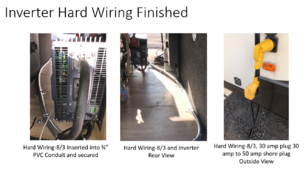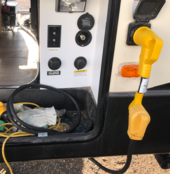It seems like this is possible if you don't want to wire the inverter into the distribution panel. Most people get an inverter/charger with a transfer switch (or inverter + transfer switch +existing converter) because they connect to the panel, but if I run the inverter as a separate circuit, do I still need a transfer switch?
I'm planning on unplugging the converter for the time being... And I guess if I need to use shore I turn off the inverter before I plug the converter back in? (Is it as simple as that?)
I would love to find a diagram to showing an inverter that isn't wired into a distribution panel, but everything I see either has that and/or an inverter/charger/switch combo. Before everyone tells me to do either of these, my camper has no room to physically accommodate something like the Multiplus or even a transfer switch. I can't imagine trying to dismantle what exists already and trying to rewire with little access. Also, my battery and solar is on the other side of camper from the converter and distribution panel, so I'm lucky I have a little bit of room to install the inverter there and not something bigger.
Advice? I'm having a hard time figuring out how to approach this given some restrictions I have on layout, access, etc. I do not mind being unable to plug things into the outlets which are connected to the AC panel and shore power. I'm not going to tear everything out and reconfigure. I would still love trying to find a diagram that shows how to properly wire up the inverter as a separate circuit so I'm not missing anything.
I'm planning on unplugging the converter for the time being... And I guess if I need to use shore I turn off the inverter before I plug the converter back in? (Is it as simple as that?)
I would love to find a diagram to showing an inverter that isn't wired into a distribution panel, but everything I see either has that and/or an inverter/charger/switch combo. Before everyone tells me to do either of these, my camper has no room to physically accommodate something like the Multiplus or even a transfer switch. I can't imagine trying to dismantle what exists already and trying to rewire with little access. Also, my battery and solar is on the other side of camper from the converter and distribution panel, so I'm lucky I have a little bit of room to install the inverter there and not something bigger.
Advice? I'm having a hard time figuring out how to approach this given some restrictions I have on layout, access, etc. I do not mind being unable to plug things into the outlets which are connected to the AC panel and shore power. I'm not going to tear everything out and reconfigure. I would still love trying to find a diagram that shows how to properly wire up the inverter as a separate circuit so I'm not missing anything.





